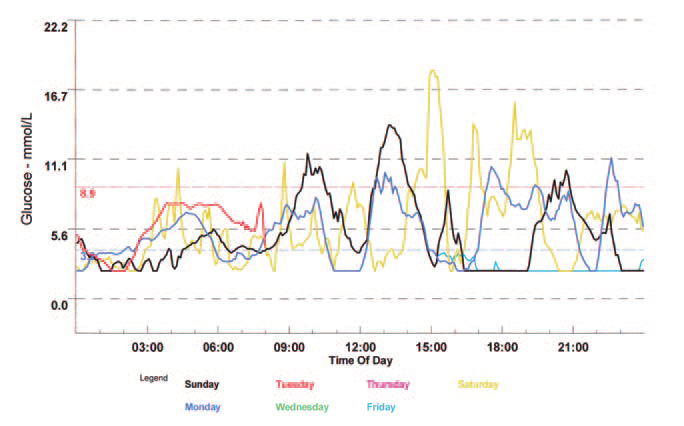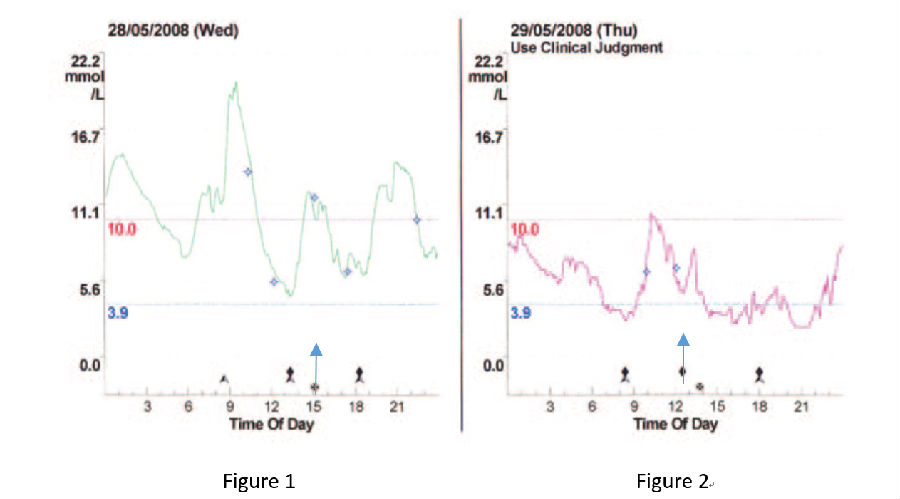Professional
CGM:How to interpret and use the data
Unlike self-monitor blood sugar test, continuous glucose monitoring(CGM) can provide continous glucose level information to optimise glycaemic control. With the improving accurancy and reliability of the sensors and the inducing cost of the technology, CGM has become more user-friendly and spaned clinical usage. To realise improvements in patient outcomes when using CGM, both health care professionals and patients need to have ability to interpret the numuous data obtained from CGM. For instance, the Poctech CT-100B CGM can provide one glucose data every 3 minutes and 3360 sensor glucose data for 7 days. In this article, I will demonstrate how to analyse CGM data with examples to spur thinking in clinical practice.
1. The glucose daily overlay
The interstitial glucose levels for each day are superimposed upon each other, which allows identification of repetitive patterns.

There is repetitive pattern overnight, with hypoglycemia from midnight until about 03:00, followed by a small degree of rebound. An adjustment of the nocturnal basal insulin dose should be rectify the problem.

This glucose curve is from a 34-year-old woman on multiple daily injections, using a once-daily insulin analogue. The following conclusions can be draw:
1) Glucose levels remain stable overnight but rise from about 05:00 to 10:00. Adjustment include:Increase basal insulin dose, but this will increase the risk of nocturnal hypoglycemia. Increase bolus insulin dose with breakfast. Change to insulin pump.
2) Glucose levels fall rapidly after lunch resulting in hypoglycemia between 14:00 and 16:00, which cause resultant hyperglycemia before dinner time . Adjustment: decrease bolus insulin dose with lunch.
PS: The adjustment on the dose of insulin should be confirmed with fingertip BG or venous BG.
2. Assess the effect factors of blood sugar, e.g. exercise
When look at each day glucose plot, we can assess the effect of exercise, the food intake, insulin dose and other factors on glucose levels.

This is an example from a 36-year-old man who suffer a sharp fall in blood sugar after excise resulting in unaware hypoglycemia.In figure1 a high starting glucose protects against hypoglycemia while infigure 2 he experiences a period of hypoglycemia(<3.9mmol/l) in 14:00-18:00 andlate in 20:00-22:00. Adjustment include:check blood sugar before exercise, take carbohydrate if necessary,avoid dangerous activity such as driving, and watch out delayed hypoglycemia.
3. The glucose meal overlay
The meal overlay view is particularly helpful when trying to assess whether insulin dosing is adequate.

In this example from an insulin pump user, there is a late fall in glucose levels after breakfast, a well control glucose after lunch but tending to rise before dinner although after dinner back to normal. Adjustment include:a decrease in basal rate before lunch and an increase before dinner. We can also find an anomalous glucose curve after dinner on Saturday. Perhaps a mistake in insulin counting before dinner, or snacking, stress happened at that time.
In 2012 USA International Diabetes Center panel discussed recommendations for standardization of analysis and presentation of CGM data, and advised to use The Ambulatory Glucose Profile(ACP) in clinical practice. CGM is comparatively considered as a useful educational, diagnostic and therapeutic tool. The health care professionals should analyse the CGM data with the impact factors such as diet, exercise and medicine to offer advices.
References:
1. Continuous glucose monitoring:the clinical picture. How to interpret and use the data. Peter Hammond,Practical Diabetes 2012; 29(9):364-368.
2. Recommendations for standardizing glucose reporting and analysis to optimize clinical decision making in diabetes: The Ambulatory Glucose Profile (ACP). Richard M. Bergenstal, Andrew J. Ahmann, Timothy Bailey, et al. Diabetes Technology &Therapeutics 2013;15(3):198-211.
Tracy Yu
Last one:nothing
Next article:nothing

A cookie is a small text file that a website stores on your computer or mobile device when you visit the site. First party cookies are cookies set by the website you’re visiting. Only that website can read them. In addition, a website might potentially use external services, which also set their own cookies, known as third-party cookies. Persistent cookies are cookies saved on your computer and that are not deleted automatically when you quit your browser, unlike a session cookie, which is deleted when you quit your browser. Every time you visit our website, you will be prompted to accept or refuse cookies.
Ensure that the website are functioning properly. These cookies are necessary for you to browse and use the functions of the website. Without these cookies, you may not be able to use and access the website normally. Analyze the usage of website in order to measure and improve the performance of website pages You are always free to decline our cookies if your browser permits, but some parts of our web site may not work properly for you if you do so. If you only read or download information on our web site, we do not collect or learn your name, e-mail address, home address, or other Personal Information about you. Our website also does not have third-party links and will not generate third-party cookies The persistent cookie may be stored on your computer's hard drive when you browsing our website. Persistent cookies are more permanent bits of information that are placed on the hard drive of your computer and stay there unless you delete the cookie.
Security is very important to us. We also understand that security is important to you. We take reasonable steps to protect all Personal Information from loss, misuse, and unauthorized access, disclosure, alteration, or destruction. Although the website uses HTTPS, but you should keep in mind that no Internet transmission is ever 100% secure or error-free. In particular, e-mail sent to or from this web site may not be secure (for example, when sending a message to our customer service office through this website site), and you should therefore take special care in deciding what information you send to us via e-mail and avoid including any personal information.
Cookie 是网站在访问网站时存储在计算机或移动设备上的小型文本文件。 第一方饼干是由您访问的网站设置的饼干。只有该网站可以阅读它们。此外,网站可能使用外部服务,这些外部服务还会设置自己的 Cookie,即第三方 Cookie。 持久性 Cookie 是保存在计算机上的 Cookie,当您退出浏览器时不会自动删除,这与会话 Cookie 不同,后者在退出浏览器时会被删除。 每次您访问我司网站时,都会提示您接受或拒绝 Cookie。
确保网站页面正常运行。这些cookies对您浏览和使用网站页面的功能是必要的,如果没有这些cookies,您可能无法正常使用和访问网站页面。 分析网站页面的使用情况,以便衡量和改进网站页面的性能 如果您的浏览器允许,您可以随时拒绝我们的 cookies,但如果您这样做,我们网站的某些部分可能无法为您正常工作。 如果您只阅读或下载我们网站上的信息,我们不会收集或了解您的姓名、电子邮件地址、家庭住址或其他有关您的个人信息。 我司网站也不存在第三方链接,不会产生第三方cookies 当你访问我司网站时,持久性cookies可能存储在您的计算机硬盘上。持久性 cookies 是更永久的信息位,它们放置在您的计算机硬盘驱动器上,除非您删除 cookies,否则它们会一直留在那里。
安全对我们来说非常重要。 我们也明白安全对您很重要。 我们采取合理措施保护所有个人信息免遭丢失、误用和未经授权的访问、披露、更改或破坏。虽然网站采用的是Https,但您应该记住,没有任何互联网传输是 100% 安全或无错误的。尤其是发送到本网站或从本网站发送的电子邮件可能不安全(例如,当通过本网站向我们的客户服务办公室发送消息时),因此您在决定发送给我们的信息时应特别小心避免包含任何个人信息。